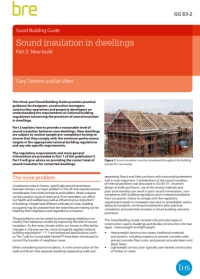Sound insulation in dwellings Part 2: New-build (GG 83-2)
BRE (Building Research Establishment) is an independent, research-based consultancy, testing and training organisation, operating in the built environment and associated industries.
Sound insulation in dwellings Part 2: New-build (GG 83-2) was written by Gary Timmins and Ian West and published by BRE on 1 August 2015.
Unwelcome noise in homes, specifically sound transmission between homes, is a major problem in the UK that requires serious consideration from both architects and builders. Noise nuisance can be a serious cause of stress and can affect our health and wellbeing. People have different attitudes to noise; building occupants may be unaware that the noise they are making can be heard by their neighbours and regarded as a nuisance.
GG 83-2 is part of a three-part Good Building Guide providing practical guidance for designers, construction managers, construction operatives and property developers to help them understand the requirements of the building regulations concerning the provision of sound insulation in dwellings.
The 12-page Part 2 explains how to provide a reasonable level of sound insulation between new dwellings, which are subject to routine pre-completion testing to ensure they comply with the minimum performance targets set out in the building regulations, as well as any site-specific requirements.
The regulatory requirements and more general information are provided in Part 1, and Part 3 gives advice on providing the correct level of sound insulation for converted dwellings.
[edit] Find out more.
[edit] Related articles on Designing Buildings Wiki
- Approved Document E.
- BRE articles on Designing Buildings Wiki.
- BRE Buzz articles on Designing Buildings Wiki.
- BRE Buzz.
- BREEAM Acoustic performance
- BREEAM Reduction of noise pollution
- Building acoustics.
- Building Research Establishment.
- Noise nuisance.
- Pre-completion sound testing.
- Robust details certification scheme.
- Sound insulation in dwellings: Part 1: An introduction (GG 83-1).
- Sound insulation in dwellings: Part 3: Material change of use (conversions) (GG 83-3)
- Sound insulation.
- Sound v noise.
- Structure-borne sound.
Featured articles and news
The UK's Modern Industrial Strategy: A 10 year plan
Previous consultation criticism, current key elements and general support with some persisting reservations.
Building Safety Regulator reforms
New roles, new staff and a new fast track service pave the way for a single construction regulator.
Architectural Technologist CPDs and Communications
CIAT CPD… and how you can do it!
Cooling centres and cool spaces
Managing extreme heat in cities by directing the public to places for heat stress relief and water sources.
Winter gardens: A brief history and warm variations
Extending the season with glass in different forms and terms.
Restoring Great Yarmouth's Winter Gardens
Transforming one of the least sustainable constructions imaginable.
Construction Skills Mission Board launch sector drive
Newly formed government and industry collaboration set strategy for recruiting an additional 100,000 construction workers a year.
New Architects Code comes into effect in September 2025
ARB Architects Code of Conduct and Practice available with ongoing consultation regarding guidance.
Welsh Skills Body (Medr) launches ambitious plan
The new skills body brings together funding and regulation of tertiary education and research for the devolved nation.
Paul Gandy FCIOB announced as next CIOB President
Former Tilbury Douglas CEO takes helm.
UK Infrastructure: A 10 Year Strategy. In brief with reactions
With the National Infrastructure and Service Transformation Authority (NISTA).
Ebenezer Howard: inventor of the garden city. Book review.
The Grenfell Tower fire, eight years on
A time to pause and reflect as Dubai tower block fire reported just before anniversary.
Airtightness Topic Guide BSRIA TG 27/2025
Explaining the basics of airtightness, what it is, why it's important, when it's required and how it's carried out.
Construction contract awards hit lowest point of 2025
Plummeting for second consecutive month, intensifying concerns for housing and infrastructure goals.
Understanding Mental Health in the Built Environment 2025
Examining the state of mental health in construction, shedding light on levels of stress, anxiety and depression.























